从跨文化交际角度浅析中西体态语的差异
- 格式:doc
- 大小:19.50 KB
- 文档页数:2
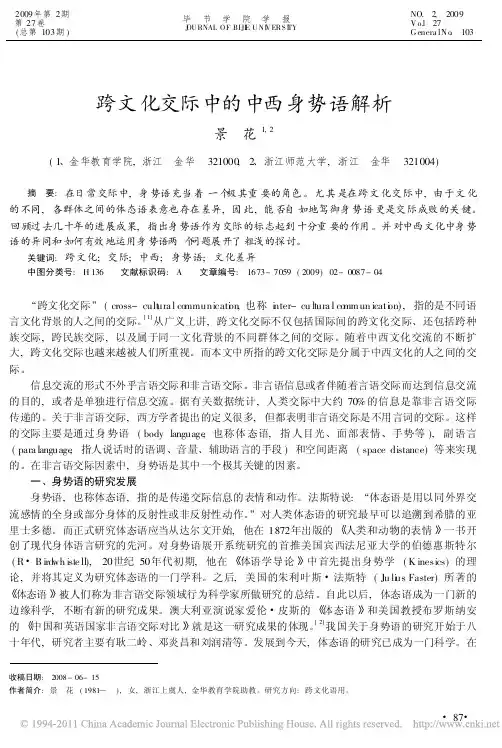
2009年第2期第27卷(总第103期)毕节学院学报J OURNAL OF BIJI E UNI VERS I TYNO.2,2009V o.l27G enera lN o.103收稿日期:2008-06-15作者简介:景 花(1981 ),女,浙江上虞人,金华教育学院助教。
研究方向:跨文化语用。
跨文化交际中的中西身势语解析景 花1,2(1、金华教育学院,浙江 金华 321000;2、浙江师范大学,浙江 金华 321004)摘 要:在日常交际中,身势语充当着一个极其重要的角色。
尤其是在跨文化交际中,由于文化的不同,各群体之间的体态语表意也存在差异,因此,能否自如地驾御身势语更是交际成败的关键。
回顾过去几十年的进展成果,指出身势语作为交际的标志起到十分重要的作用。
并对中西文化中身势语的异同和如何有效地运用身势语两个问题展开了粗浅的探讨。
关键词:跨文化;交际;中西;身势语;文化差异中图分类号:H136 文献标识码:A 文章编号:1673-7059(2009)02-0087-04跨文化交际!(cross-cult u ra l co mmunicati o n,也称i n ter-cu ltura l co mm un icati o n),指的是不同语言文化背景的人之间的交际。
[1]从广义上讲,跨文化交际不仅包括国际间的跨文化交际、还包括跨种族交际,跨民族交际,以及属于同一文化背景的不同群体之间的交际。
随着中西文化交流的不断扩大,跨文化交际也越来越被人们所重视。
而本文中所指的跨文化交际是分属于中西文化的人之间的交际。
信息交流的形式不外乎言语交际和非言语交际。
非言语信息或者伴随着言语交际而达到信息交流的目的,或者是单独进行信息交流。
据有关数据统计,人类交际中大约70%的信息是靠非言语交际传递的。
关于非言语交际,西方学者提出的定义很多,但都表明非言语交际是不用言词的交际。
这样的交际主要是通过身势语(body language,也称体态语,指人目光、面部表情、手势等),副语言(para language,指人说话时的语调、音量、辅助语言的手段)和空间距离(space distance)等来实现的。
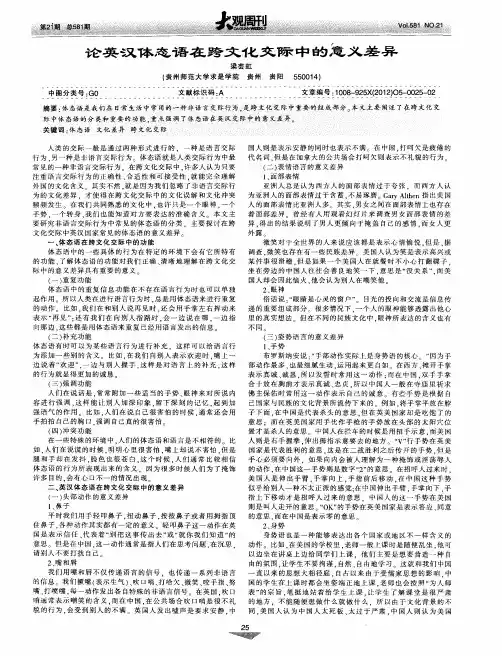
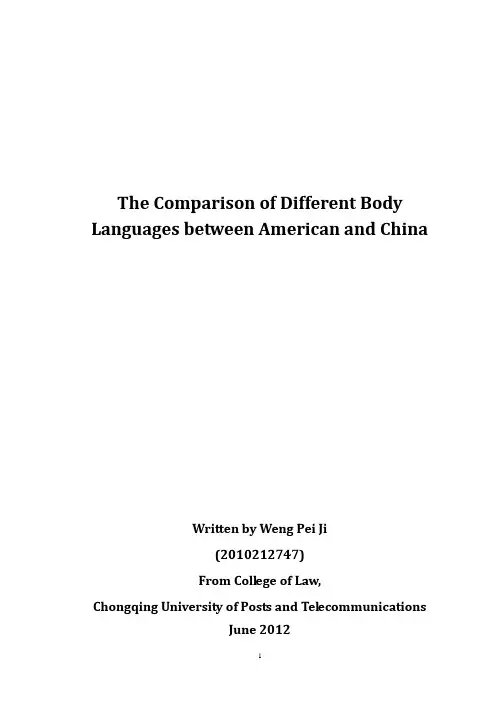
The Comparison of Different Body Languages between American and ChinaWritten by Weng Pei Ji(2010212747)From College of Law,Chongqing University of Posts and TelecommunicationsJune 2012Outline1. Introduction2. Classifications of body language2.1 facial expression and eye language2.2 gestures2.3 Postures3. Similarities of body language in Chinese and American culture3.1 facial expressions3.2 Sign language3.3 Postures4. Differences of body language in Chinese and American culture4.1 Eye language and facial expressions4. 2 gestures4. 3 Postures5. ConclusionReference摘要:交流不是只有口语,还可以通过肢体语言。
肢体语言也可以表达情感,交流思想和交换信息。
然而,在过去很久时间里,人们只注重口语的重要性而忽略了肢体语言和它的独一性。
本文致力于中美肢体语言的对比,来减少交流中的麻烦,进行更有效的交际。
Abstract : The communication between people can not only through the spoken language, but also through the body language. As spoken language, body language can express feelings, exchange ideas and communicate informations. However, in a long past time, people only pay attention to the importance of the spoken language, and ignore body language and it’s unique cultural connotation. This paper focus on the comparison of different and similar body language between China and American so that people can reduce the communication obstacles and promote efficient communication.Keywords :body language , cultural difference , China , American, communications1. IntroductionBody language is a means to use the body movements or actions to replace or assist the sound, oral language, or other means of communication to communicate with others. A nd through people’s body language we can get some information about their own culture. Psychologists believed that the information delivered by a person’s appearance and actions is much more than t hat of a person’s words.Albert Mebrabian, after a long-time study, concluded that body language can help verbal-express achieve more effective communication. Body language can reveal people’s hidden mind and emotion, Bird Whistell who is the leader in study of body language in the west. He believes that among all means of expressing emotion and attitude, more than sixty percent is finished by facial expression, gestures, postures.2. Classifications of body languagePsychologists believe that body language includes the following aspects:2.1 facial expression and eye languageThe face has been called an ”organ of emotion”. Compare with words, facial expression is a natural way to reveal person’s emotion. The face is the most simple and important broadcaster of emotion. For example , Eye behavior is an important part of facial expression. People often say that eyes are the window of soul, because eyes can give us a lot of real information. We can know whether people like us or not from the way they look at us .And through one’s eyes we can know whether the pay attention to our topics or not.2.2 gesturesEverybody uses their hands to communicate with other people .People can convey ideas, information and message by using the movement and style of hands and fingers. What’s most directly, we use our thumb to praise other and use our middle finger to despise someone. When expressing doubt or helplessness, westerners like to shrug their shoulders and spread out hands, but Chinese people only wave their hands simply.2.3 PosturesPosture can give others many messages. which is a matter of how people sit, stand, walk and move. From people’s posture, we can conclude something.For instance, when we see a person doesn’t stand up and tall, we say the person is not energetic, competent and unconfident. On the other hand, we can conclude that a person is not concentrated in what they are discussing if he standing lazily, and so on.3. Similarities of body language in Chinese and American cultureFirst ,we discuss the similarities of body language in china andAmerica .For instance:3.1 facial expressions(1) Knit one's brows said he is unhappy ,you shouldn’t talk to him too long.(2) Shrugged his nose means he don't like what he see or what you do. Gnash his teeth means he is angry or make up his mind.3.2 Sign language(1) The signal “V” means “victory” .When someone succeed or overcomesome difficulties , someone usually do this gesture.(2) “OK” means “consent”. we often use it to show our positive ideas. And when someone don’t like your idea ,he just shaking his head and say “No”.3.3 Postures(1) When a man meet another man ,they generally shake hands to express their friendly.(2) Waved hands means goodbye,Shrug one’s shoulders means negative, uninteresting. we use it to show that we don’t know when asked by others in our daily life.4. Differences of body language in Chinese and American cultureDon’t understand body languages from different culture will bring about a lot of misunderstanding and conflicts. Therefore, it is of great importance for us to understand the body language in intercultural communication. For instance:4.1 Eye language and facial expressionsAmerican people have an old proverb: Never trust a person who can't look you in the eyes. While the Chinese people in conversation, the two sides are not necessarily time to time to look at each other, some people have also deliberately avoided continued eye contact to show humility, obedience or respect. This may be one of the reasons that the American people in China think Chinese are not warm and friendly; but also explain why the American people like to talk face to face, and the Chinese people tend to have a heart-to-heart talk. It is a habit of American people that the two sides look ateach other while they are talking, but they hate staring, because in their view this is a very rude behavior. American people find that they are as statues of rare animal camel being looked up and down, and the stare at them makes them feel very angry. However, to gaze at people in China, sometimes means only a curiosity and surprise, not rude.4. 2 gesturesThe implication of gestures is diversity, especially in cultural differences. Here we will take some gestures for example.(1) American people with the thumb and index finger to form a circle, means “OK”, but in China the “O”gesture is often used to represent the “zero”.(2) Indicate the number “3”, the Chinese people have thumb and index finger form a circle fingertips phase, the other three fingers stretched open; the American people straight index finger, middle finger and ring finger, little finger to thumb catch.(3) The “V” gesture, In America, it means victory but not the number. In China, sometimes, people think that this gesture means the number “2”.(4) American require a lift, the gesture is thumb-up when facing a coming traffic; in China, facing a vehicle, riders stretch one arm to the side, palm forward, make a “stop” gesture, or holding the right hand or both hands, say hello to the driver.4. 3 Postures(1) In intercultural communication, the presentation of posture also reflects the differences between Chinese and American, such as, according tothe Chinese tradition, the seated person is the dominator, so the young generations always give up their seat to the old. However, in America, it is quite opposite. Western culture emphasizes the “Ladies first”, so it is a courtesy that Ms. seated before the men pulled out a chair obligation to help them, and this is also a cultured, civilized performance.(2) Moreover, in the classroom, the Chinese teacher questions, students usually stand up and answer the questions; in the U.S., students generally sit to answer the United States teachers.(3) American people stood stamping their feet, means impatient; Chinese stomping, shows angry, angry, frustrated, and regret.(4) American people are standing and walking with the posture of athletes and military, standing up tall, swaggering, big strides forward; in the eyes of Americans, Chinese with standard posture of scholars and civilians.5. ConclusionFrom the above, we have studied the differences and similarities of body language used by Chinese and American. We can see that body language cannot be separated from culture. In intercultural communication, we not only pay attention to the verbal language study, but also emphasize the study of body language. Body language is the signal and tool of human communication and human being has the same ancestors, so In order to make a successful intercultural communication, we should know the body language of different cultures.Reference1.张爱琳,(2010),《跨文化交际》,重庆大学出版社;2.陈邦玲,(2004),非语言交际在跨文化交际中的作用,安徽农业大学学报;3.贾玉新,(1997),跨文化交际学.上海外语教育出版社;4.刘慧,(2008),身体语言的魅力。

从中西方肢体语言看文化差异(根据调查研究:当我们在与他人进行沟通时,语言只是起到7%的传达的作用。
语气却占去剩下的38%。
更重要的是:肢体语言在沟通中起到了55%的影响。
(相对于沟通的内容和环境)那么,什么是肢体语言?肢体语言(body language)是指能够传递某种特定信息的面部表情、手势语,以及其他身体部位的动作等等。
它在人际交往过程中起着非常重要的作用。
由于社会的发展,国与国之间的交流不断加强,西方的许多肢体语言在我国也已经被认同,还有一些被普遍适用。
比如:西方人往往指胸口来表示“我”。
大拇指朝上,表示“好”;但大拇指朝下则表示“坏,糟透了”。
还有用大拇指指尖与食指指尖相接成O形,伸直其余三个指头,表示OK,即“正常”、“顺利”、“没问题”。
伸出食指和中指成V形,表示victory(胜利)。
如果招手示意别人过来,他们是伸出手,掌心朝上,捏拢四指,前后弯动食指。
当然,在中国和西方国家中,肢体语言其含义也存在不同程度上的差异。
不过,很多肢体语言表达的含义还是一致的,比如,点头表示:同意或者表示明白了,听懂了;眉毛上扬表示:不相信或惊讶;避免目光接触意味着:冷漠,逃避,不关心,没有安全感,消极,恐惧或紧张等;摇头表示:不同意;鼓掌:赞成或高兴等等,但是在这里,我们主要通过分类来说明,在不同的文化背景下,不同的肢体语言在不同程度上所存在的差异,了解从中体现出来的文化差异,从而提高我们学习语言的兴趣。
一、动作一样,意义不同(the same action,different meaning)。
如下例:1. 跺脚(stamp one’s foot):在中国人看来,表示气愤,恼怒,灰心,悔恨。
比如说:气得直跺脚。
而它的英文含义则是不耐烦,比如:give a stamp of impatience(不耐烦得跺脚)。
2. 目不转睛地看(look with fixed gaze):其中文含义是:好奇;有时是惊讶。
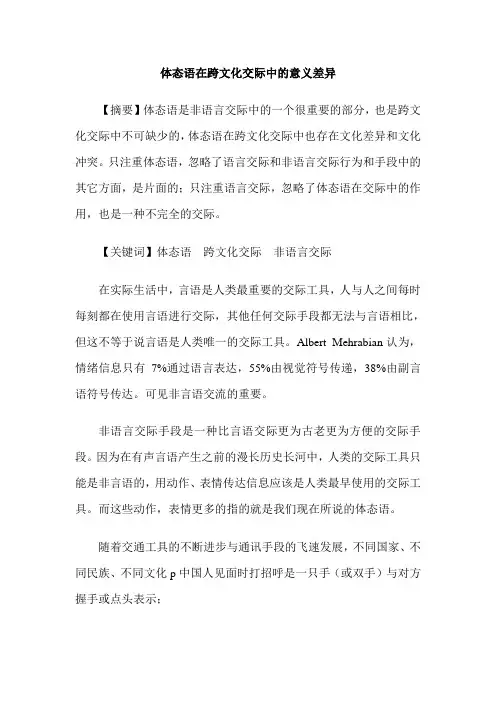
体态语在跨文化交际中的意义差异【摘要】体态语是非语言交际中的一个很重要的部分,也是跨文化交际中不可缺少的,体态语在跨文化交际中也存在文化差异和文化冲突。
只注重体态语,忽略了语言交际和非语言交际行为和手段中的其它方面,是片面的;只注重语言交际,忽略了体态语在交际中的作用,也是一种不完全的交际。
【关键词】体态语跨文化交际非语言交际在实际生活中,言语是人类最重要的交际工具,人与人之间每时每刻都在使用言语进行交际,其他任何交际手段都无法与言语相比,但这不等于说言语是人类唯一的交际工具。
Albert Mehrabian认为,情绪信息只有7%通过语言表达,55%由视觉符号传递,38%由副言语符号传达。
可见非言语交流的重要。
非语言交际手段是一种比言语交际更为古老更为方便的交际手段。
因为在有声言语产生之前的漫长历史长河中,人类的交际工具只能是非言语的,用动作、表情传达信息应该是人类最早使用的交际工具。
而这些动作,表情更多的指的就是我们现在所说的体态语。
随着交通工具的不断进步与通讯手段的飞速发展,不同国家、不同民族、不同文化p中国人见面时打招呼是一只手(或双手)与对方握手或点头表示;欧美人常以拥抱和亲吻来表示;日本人常以鞠躬来表示;库泊爱斯基摩人用拳头捶打对方的头和肩来表示;萨摩亚人用互相嗅闻对方来表示;瑞典的拉普人用互擦鼻子来表示;太平洋群岛上的波利亚人见面时常用边拥抱、边抚摸对方的后背来表示;拉丁美洲有些地方用拍背来表示;可见,在有声言语交际可能遇到困难的情况下,体态语在跨文化交际过程中存在的意义差异,将直接影响双方交往的顺利进行。
体态语在跨文化交际中的意义差异主要表现在以下五个方面:1 眼神在人们身体能够传递信息的部位中,眼睛是最重要、最能传递微妙信息的部位。
眼睛能够表示兴趣、厌倦、移情、敌视、理解、误解和其他信息。
而调控眼睛的重要手段是眼神。
眼神最能表示人的内心活动,所以眼睛被称为“心灵的窗户”。
比如,睁大双眼可以表示愤怒或惊讶;半睁双眼可以表示困惑或轻视;睡眼朦胧可以表示困倦或厌倦等等。

目录一、体态语的概述 (2)二、中西体态语的文化差异及交流障碍 (2)(一)体态语文化差异的根源 (3)(二)体势语的文化差异 (3)(1)面部表情 (3)(2)手势 (4)(3)身体其他部位 (6)(三)体距的文化差异 (6)(四)体触的文化差异 (7)三、总结 (8)四、参考文献 (8)中西文化差异及其交流障碍中西体态语文化差异及其交流障碍专业名称:初等教育英语方向作者:郑婷摘要:体态语是人类多种交际方式中至关重要的一种。
成功的人际交往很大程度上依赖于无声表达自己以及准确理解别人的体态语的能力。
只有体态语和有声语言相互结合相互补充,才能够达到交际的最佳效果。
而中西体态语文化因历史、政治、民族等条件的不同,具有一定的差异性。
为了克服交流障碍,可以从体势、体距、体触三方面来了解体态语的文化差异。
关键词:体态语;体势;体距;体触一、体态语的概述提到交流,我们自然会想到语言,即我们每天说的不计其数的话。
但是,除了有声语言,还有一种对我们日常的交流做出了巨大贡献的身体语言──体态语。
体态语是一种表达和交换信息的可视化(有的伴声)符号系统,它由人的面部表情、身体姿势、肢体动作和体位变化等构成。
或者通俗地讲,当人体动作能够传递相关信息时,这些动作有了语言的功能,就成为体态语了。
在现实生活中,体态语使用极其广泛,而且有时更能无声胜有声地巧妙表达信息,同时留给对方更大的想象空间。
心理学家得出一个有趣的公式:一条信息的表达=7%的语言+38%的声音+55%的人体动作。
这表明,人们获得的信息大部分来自视觉印象。
因而美国心理学家艾德华·霍尔曾十分肯定地说:“无声语言所显示的意义要比有声语言多得多。
”人类的体态语具有一定的共性,语言不通、地域不同、文化相异的人们可以通过体态语进行一定程度上的有效交流。
然而,共性的体态语主要是指一些先天性动作(如欢乐之笑,痛苦之哭)和自发动作(如双臂抱胸,双腿交叉等),而更多的体态语却是后天习得的,根植于本民族的历史文化传统和社会宗教环境中,从而具有了各自的民族特性,自然而然体态语的文化差异就产生了。
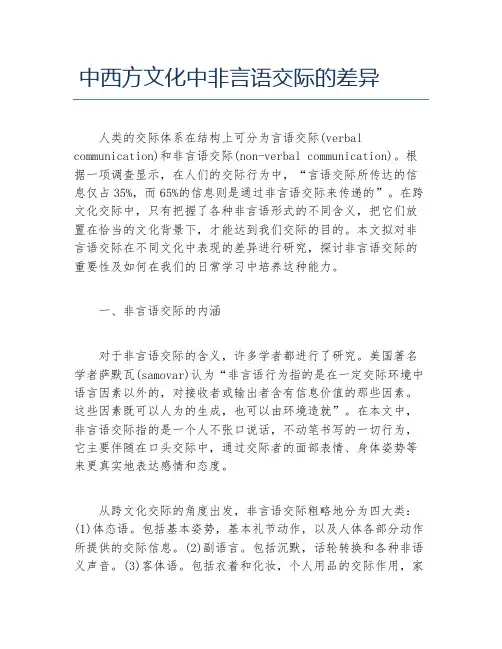
中西方文化中非言语交际的差异人类的交际体系在结构上可分为言语交际(verbal communication)和非言语交际(non-verbal communication)。
根据一项调查显示,在人们的交际行为中,“言语交际所传达的信息仅占35%,而65%的信息则是通过非言语交际来传递的”。
在跨文化交际中,只有把握了各种非言语形式的不同含义,把它们放置在恰当的文化背景下,才能达到我们交际的目的。
本文拟对非言语交际在不同文化中表现的差异进行研究,探讨非言语交际的重要性及如何在我们的日常学习中培养这种能力。
一、非言语交际的内涵对于非言语交际的含义,许多学者都进行了研究。
美国著名学者萨默瓦(samovar)认为“非言语行为指的是在一定交际环境中语言因素以外的,对接收者或输出者含有信息价值的那些因素。
这些因素既可以人为的生成,也可以由环境造就”。
在本文中,非言语交际指的是一个人不张口说话,不动笔书写的一切行为,它主要伴随在口头交际中,通过交际者的面部表情、身体姿势等来更真实地表达感情和态度。
从跨文化交际的角度出发,非言语交际粗略地分为四大类:(1)体态语。
包括基本姿势,基本礼节动作,以及人体各部分动作所提供的交际信息。
(2)副语言。
包括沉默,话轮转换和各种非语义声音。
(3)客体语。
包括衣着和化妆,个人用品的交际作用,家具和车辆所提供的交际信息。
(4)环境语。
包括空间信息,时间信息,声音、灯光、颜色标识等等。
本文主要对其中一些常见的非言语交际进行研究。
二、中西方文化中非言语交际的差异人们在语言交流过程中,会时不时的伴随有各种各样的“小动作”,这些小动作其实也是对交际的一种补充。
它的作用也是不容忽视的。
1,体态语。
非言语交际中最常见的就是体态语的运用。
体态语是指人们利用姿态、动作,包括身体动作和面部表情,来传达信息的非言语行为。
下面就手势、面部表情、目光语等等来分析一下这种差异性。
一、手势上的差异性。
不同的文化下,人们利用手势所表现出来的意义也是不同的。

四川外语学院继续教育学院本科毕业论文外文题目and British Cultures in专年2010年6月18日On the Differences b etween Chinese and British Cultures i nIntercultural CommunicationAbstractAlong with the deepening of reform and opening up,the rapid developments of economy,science and technology and the tendency of globalization have brought China into direct and indirect contact with other countries.While because of the diversity of world culture,people from different countries often behave in such different ways which makes us do not understand. This may result in communication failure.In intercultural communication, people should study the differences between cultures,in case of communication failure.Great Britain,an island country,is located in Europe,while China is an Asian country.Cultural differences are quite different.Beginning with the introduction,this thesis describes the role of intercultural communication plays in international communication.In order to describe the intercultural communication,the second part of this thesis defines the communication and intercultural communication,and represents the development of intercultural communication.In the third part,this thesis describes something about culture,including the definition,classification,characteristics and differences of culture.The forth part is the core of this thesis,it analyses the differences between Chinese and British cultures in verbal communication and nonverbal communication.And the last part is a conclusion.Key words:communication failure;intercultural communication;verbal communication;nonverbal communicationIntercultural CommunicationOutlineThesis Statement:The differences between Chinese and British cultures arereflected in verbal communication and nonverbalcommunication.I.Introduction:The prevalence of intercultural communicationII.Intercultural CommunicationmunicationB.Intercultural Communication1.Definition of Intercultural Communication2.The Development of Intercultural CommunicationIII.CultureA.Definition&Classification of CultureB.The Characteristics of CultureC.Cultural DifferencesIV.The Cultural Differences between Chinese and British in Intercultural CommunicationA.Cultural Differences in Verbal CommunicationB.Cultural Differences in Nonverbal CommunicationV.ConclusionEndnotesBibliographyIntercultural CommunicationⅠ.I ntroductionIn modern society,with the rapid development of economy,science and technology,transportation and communication are progressing with each passing day.More and more people live,study and work in different populations,people of different cultural backgrounds contact with each other more and more frequently.In the process of being“Global Village”,we are directly and indirectly contacting with other people,because of the cultural diversity,they often behave in such different ways that we do not understand them.Various cultures interact,infiltrate,absorb and fuse each other in the contacting and collision,this will affect intercultural communication.It not only needs the ability of language,but also the culture of English countries,when communicate cross cultures in English successfully.Otherwise,in the process of communication,improper or inappropriate pragmatic failure will appear, causing misunderstanding because of cultural difference.In order to avoid more culture conflicts between different countries, understanding the cultural differences in cross-cultural communication is a required course.This paper analyses the differences of verbal communication and non-verbal communication between Chinese and British Cultures in intercultural communication.Ⅱ.Intercultural CommunicationmunicationThe history of communication is as long as that of human beings. Communication appeared since the emergence of human.And communication, which is everywhere,develops along with the development of human society.However,because of its diversity,communication is difficult to define accurately.There are3definitions in OALD1:1.[U]the activity or process of expressing ideas and feelingsor of giving people information.2.[U]methods of sending information,especially telephones,radio,computers,etc.3.[C](formal)a message,letter or telephone call.In Longman Dictionary of Contemporary English,communication is defined as:“the process by which people exchange information or express their thoughts and feelings.”2The most universal definition is that communication is“the exchange of information and the transmission of meaning”.(Katz&Kahn,1996)A Chinese scholar Mr.Zhang Guoliang defines communication as:“communication is the process in which one party gives the message that is received by the other party”. (Hu Wenzhong,1999)Actually,almost all communication scholars agree to communication is a process.Thus it can be seen that communication is the process of people contacting and exchanging information with each other.Throughout history,lots of scholars have different opinions about communication,as a matter of fact,the definition of which could be divided into two schools.One is“persuasion”,regarding communication as the process of expressing information so as to influence the action of receiver.The other one is“sharing”,thinking communication is the process of sharing,that is,the process of turning the information of minoritysharing into the information of majority.B.Intercultural Communication1.Definition of Intercultural CommunicationIntercultural communication,also called cross-cultural communication,is the communication between native speaker and non-native speaker,also the communication of people in different language and culture.Generally speaking, intercultural communication is what you should pay attention to,and how to communicate properly,when you communicate with foreigners.2.The Development of Intercultural CommunicationWherever the people of different cultural backgrounds contact,cross-cultural communication will happen,and even can be said that the history of cross-cultural communication is the history of human.Intercultural communication occurs whenever there is communication between people from different cultural backgrounds,for example,what happened on the Silk Road,Marco Polo’s stay in China,Monk Jianzhen’s mission to Japan,and Zheng He’s seven voyages to the Western Seas—they tell us that intercultural communication is as old as history.Nevertheless,as a discipline,its history is short.Intercultural communication as a field of study first emerged in the United States in the1950s.United States is a nation of immigration,where culture conflict occurs at any time.Immigrants from world highlight and preserve their own culture,thus create the multi-cultural pattern of United States.Therefore intercultural communication raised the attention of American scholars and public.Edward Hall3is considered the father of intercultural communication with his population of The Silent Language in1959and his many other works.The 1960s was the period of conceptualization of the field by communication scholars.The1970s showed a rapid development,reflected in the publication of numerous studies.During the1980s the field moved toward integration and aclearer identity.The1990s stressed diversification of methods,displayed increased concern with domestic co-cultures,and also witnessed efforts to redress historical and colonial imbalances.By the end of the20th century,there was as many as nineteen specific intercultural communication theories put forward.(Gudykunst,2003)And Japan was unwilling to be left behind,in1972,the first International Conference on intercultural communication held in Tokyo,which has more than 2000people attend ing.In1974,SIETAR(Society for Intercultural Education, Training and Research)was found in America.The study of intercultural communication in China started late.Professor Hu Wenzhong,the famous linguist of Beijing Foreign Studies University,engaged in the research of cross-cultural communication in early1980s,now has published Introduction to Intercultural Communication,Cross Culture and Language Communication,and many others books.At present cross-cultural communication has become a comprehensive branch of anthropology,linguistics,psychology,communication, sociology and other disciplines which are valued by international scholars.Ⅲ.C ultureA.Definition&Classification of CultureThe word“Culture”is widely used in daily life and academic works, people seem to know the meaning of it.However,the understanding and application of all kinds of people under all kinds of circumstances are differing in thousands of ways.“Culture”in culturology is the most basic concept and terminology,before studying the cultural difference,firstly,define“culture”.According to The Contemporary Chinese Dictionary,there are three definitions of culture:A.the sum of material wealth and spiritual wealth created bypeople in the process of social history,especially the spiritual wealth,such as literature,art,education,science and so on.B.Archaeological terms,refers to a complex of relics andlegacy which are not transferred according to distribution.The sametools,equipment,manufacturing technology are the features ofsame culture,such as Yangshao Culture,Longshan Culture.C.the ability of using language and general knowledge:learning culture,cultural level.4While in OALD,the definitions of culture are:1[U](a)refined understanding and appreciation of art, literature,etc.(b)(often derog)art,literature,etc.collectively.2[U]is the state of intellectual development in a society.3[U,C]is particular form of intellectual expression,e.g.in art and literature.4[U,C]culture is customs,arts,social institutions,etc.of a particular group or people.5[U]is developments through training,exercise,treatment, etc.6[U]culture is the growing of plants or rearing of certain types for animals(e.g.bees,silkworms,etc.)to obtain a crop or improvethe species.7[C](biology)groups of bacteria grown for med ical or scientific study.5Therefore,it’s not difficult to find that the understanding of culture between Chinese and westerners is not totally same.While views in cultural differences exits not only between Chinese and westerners,but also among scholars in different countries even the same country.Because of the differences of perspective,scope or theory,the definition of culture is not the same.It’s said that there are over a hundred definitions,thus culture is a complex object.For a long time,anthropologist believe that culture is the living style of a nation,that is,the patterns of behavior,attitude and achievement learned by the members of the nation.With the passage of time,the concept of culture has gradually changed.A famous British anthropologist Tylor6defines culture as:“The so-called culture or civilization,to its broad ethnographic sense,is an overall composite which knowledge,belief,art,morals,law,custom,and any of the members of the society as acquired all ability and habits.”(1871)this is the earlier and more comprehensive definition put forward by anthropologists,still used by people.Herskovits holds that,culture is the creation of artificial environment,that is to say,except nature;all the things added by people could be called culture. The things people create include two kinds:one is objective culture,the hardware product,the other one is subjective culture,the software product. Hardware is the tangible articles,such as housing,transportation,computer,TV and other mechanical devices.While software is intangible,which exists in everywhere,such as belief,ideal,value and social norms?They are affecting people like air and sunshine.(1955)This definition is very comprehensive,but not used by many scholars. With more widely used is the subjective culture,that is,culture is a shared value system.Geert Hofstede once refers to culture as“the software of mind”,and points out culture affects people,what concerns,how to act and how to judge people and things.To sum up,culture can be defined as“the material wealth and spiritual wealth created by people,through the inspection of history.”Culture almost includes every aspect of human society,so the classification is numerous.Professor Xing Fuyi divided culture into material culture,institutional culture and mental culture.Among them,material culture refers to material civilization created by people,all visible and tangible material and spiritual product,including diet culture,costume culture,architectural culture,drama culture,etc.Institutional culture is the social norms,involving the human social system,religious system,producing system,educational system, labor management system,family system,relationship system,custom system, behavior system,and various theories associated with them.Mental culture is defined as human thinking mode,thinking habits,value,aesthetic temperament, belief and mentality.B.The Characteristics of CultureAll theses definitions are not mutually exclusive that culture is a reflection of human life,record of activities,deposit of history,which also the people’s needs and requirements of life,ideals and wishes.People acquaint with nature, think about themselves on culture which includes some thoughts and theories. Culture is the method and standard of human’s survival,meanwhile thoughts and theories are the soul of culture,there are no thoughts and theories without culture.Although there may not be a standard definition of culture,there are lots of characteristics of culture which describe its essence.Firstly,culture is something shared by a group.Secondly,these things can be objective dominant,and subjective implicit.Moreover,the objective dominant and subjective implicit culture affects every aspects of the group.Last but not least,culture,from generation to generation,is organic. Although it is advancing with times extremely slow.And there are differences between different cultures.C.Cultural DifferencesCultural differences are reflected in all aspects of culture,such as religious beliefs,values,mode of thinking,lifestyle,philosophy,language,history,diet, time,space,interpersonal relationships and so on.Samovar,American semiologist,once pointed out that when a message left the culture of encoder,it carried the meaning which coder expressed.When arrived in the receiver,it would affected by the code culture.In the encoding process of intercultural communication,the connotations of the original information will be modified,the greater the difference in communication between the two parties,the greater the degree of tampering,which shows that the greater the cultural differences,the greater possibility intercultural communication occurs.Therefore,it’s beneficial to reduce misunderstanding and improve communication that has knowledge of both the degree and point of cultural differences.Ⅳ.T he Cultural Differences Between Chinese and British inIntercultural CommunicationThe full name of Britain is the United Kingdom of Great Britain and Northern Ireland.It is a complicated name for what is in many ways a complicated country.Most people know something about it because its huge overseas empire.The British state is a group of islands situated off the continent of Europe, which is made up of Great Britain(England,Wales and Scotland)and Northern Ireland.British always regard their country as“four nations,one kingdom”.One kingdom is the United Kingdom;four nations are English,Scot,Welsh and Irish. People from Scotland,Wales or Northern Ireland would like to be called British, instead of English.China is located in eastern Asia,the west bank of Pacific,which is a country with land and sea.A.Cultural Differences in Verbal CommunicationLanguage,the carrier of culture,is an inseparable part of culture.It not only reflects culture,but also influenced by culture.In addition to the structure rules,includes voice,vocabulary,grammar,the use of language also constrained by the use rules.The use rules prefer to the social culture which language belongs to,while social culture measures the appropriateness of using language. Due to the cultural transfer,foreign language learners often put their own culture model into a new culture,and“culture has unity,continuity,communism,but also differences and variability.”(Hu Wenzhong,1985)The form and application of language are restricted,affected,determined by cultural content.The form of different language application display different cultural characteristics.Because of different education,people of different backgrounds have different ideology,beliefs,style and customs system. Therefore,owing to the great cultural differences,people often suffer from the barrier of communication.In the practical communication,the factors of cultural differences mainlymanifested as follows:vocabulary,customs,values and way of thinking.They affect the principles and expression of language directly and fundamentally, affect the cognition and mastery of language learners,affect the success or failure of verbal communication.Vocabulary,an important component of language,is the carrier of language information.“The learning of vocabulary is related to the relationship between words and the outside world,as well as the relationship between words.”(Wilkins)Words are used to express concept,while concept is the result of perceptual knowledge and theoretical understanding.When people see a word, they will think of what it means,and link the meaning to objective facts or imagined things,forming an image in mind.On the same word,the image or association which of different people,may be completely different.The phrase“east wind”in Chinese reminds people of spring,while“west wind”makes people feeling cold winter.But in English,there are some phrases,“biting east wind”,“It is warm,blowing a west wind,full of birds crying.”Same phrases have totally different meanings.China faces sea in the east;east wind from sea is pleasure,while the west wind from Siberia is frozen.Britain is an island country,surrounded by the sea.It is separated from the rest of Europe by the English Channel in the south and the North Sea in the east.East wind is from European continent,the west wind blow from Atlantic Ocean,which is warm and pleasant.Thus,the differences on geography are one of the reasons making cultural differences between China and Britain.In English,the word“dear”is used in many situations to anybody whom you want to show your respect or intimacy,while in British families,they often use“darling”,“sweet heart”to show their love,although sometimes“dear”is also used.But in Chinese,“dear”is not so popular in family.First comes to customs.There are a large number of obvious differences between China and Britain in address,greeting,modesty,praise and some other daily communication.If people are not familiar with those communication rules, they will fail to communicate,even cause negative consequence.Since China has about three thousand years of history of feudal society, feudal ideas are deep-rooted in the minds of people.People attach great importance to blood relationship,emphasiz e the social status,advocate respecting the aged and taking good care of children.Nevertheless,Britishpursue equality,address is much simpler.Both paternal and maternal grandfather are“grandpa”.Whether mother’s brother or father’s brother are“uncle”.Even British children call their elders by their name.But it is not polite in Chinese.A common Chinese form of address is the use of a person’stitle,office,or profession,such as“张局长”,“李经理”,“严校长”.But one seldom hears English speakers addressing others as BureauDirector Smith,Manager Jackson,Principal Morris,etc.In English,only a few occupations or titles are used such as Doctor,Judge,Governor,Mayor,Professor,Nurse and ranks in the armed forceslike Captain.These can be used either singly or with the person’ssurname.(Deng Yanchang,et al.,1989)7Greetings are so common in both Chinese and English.When people meet, they usually greet each other.The purpose of the greeting is to establish or maintain social contact,not to transfer information,so formulaic expressions are often used.The following greetings are common in British English:“Hey.”“Hello.”“How do You do?”“Good morning/afternoon/evening.”“How is everything?”“How are things going?”They are more formal than American English.In Chinese,there is a very similar set of phrases like the following:“Where have you been”,“Where are you going”,“Have you had your meal”. British would be puzzled,when hear such greetings.Their natural reaction to these Chinese greetings would be:“It’s none of your business!”or regard it as an invitation to dinner.Chinese are known for modesty.Several thousand years ago,Confucius has educated his disciples be modest.The deep-rooted Confucianism has influenced Chinese people.Even Chinese modesty could be described as “humble”.In foreigners’view,quality of the British,and in particular of the English,is“reserved”.A reserved person is one who does not talk very much to strangers,does not show much emotion,and seldom gets excited.It is difficult to get to know a reserved person.As the same as the British,he never tells others anything about himself.Closely related to British reserve is British modesty. Within their hearts,the British are perhaps no less conceited than anybody else ofother countries,but in their relations with others they value at least a show of modesty.Self-praise is felt to be impolite.Even a British had managed to reach the finals in last year’s local championships;he would say it in such a way as to suggest that it was only due to a piece of good luck.British conservativeness is known to the world,but they think their behavior is the best,the most reasonable.Along with human entering into21st century,British people are in a huge change.British used to embarrass to express emotion in public.However,the famous British“stiff upper lip”has become a thing of the past,according to a survey which found Briton are no longer embarrassed to her a tear or be affectionate in public.Briton are also prone to getting carried away when they are excited,the research showed,with47percent waving their arms in the air,a third jumping up and down and three in10 throwing their arm around someone nearby.When receiving compliments from others:“You did a good job!”or“You look great!”Chinese people often say:“No,no,I didn’t do it well!”“I am not.”This may owe to Chinese modesty.But such respond may make a Briton think you lack of confidence,or you are just pretend ing,which they don’t like and can’t understand.Just respond like Briton:“Thank you!”In daily communication,Chinese always start conversations like this:“Where are you from?”“How old are you?”“Are you married?”“How much do you earn?”but little attention paid to the answers already given.However,such kinds of topics are regarded as private matters for British people,which Chinese should therefore be careful about discussing it with Briton.British people attach great importance to privacy.Generally speaking,it is regarded as impolite in English culture to ask a person his or her age.This is particularly true of woman when she is over thirty.So a direct question like“How old are you?”should be avoided.It is very common in China to ask someone’s salary in the past.Salary is also regarded as extremely personal and private in Britain.It is better to avoid questions like“How much do you earn?”Actually,there are many topics that are acceptable to both Briton and Chinese,such as the following:hobbies,holidays,the weather,films or books.When part,especially for an important guest,Chinese host will see him or her to the build ing gate,or even to the bus stop and say some thing like:“Walk slowly.”“Watch your step.”Sometimes they will not go back until the guest isout of sight.In contrast to this,British host will see the guest to the door and say thing like“Thank you for coming.”Next comes to values and way of thinking.“Traditional values are the core of culture.”(Hu Wenzhong,1992)Every social system has its own unique value system,which directly affects the way people are thinking and communication rules.Value system plays a mandatory role in people’s social life.For people belonging to a certain culture,behavior is dominated by the values,which belongs to the language.The traditional Chinese view is“The Unity of Man and Heaven”,that is,people live in unity and harmony with nature.The theory reflected in thinking model is integrated thinking,is a priority of the overall cognitive activity,reflected in language is integrated sentence.This model of thinking,first of all,pay attention to the overall image,and then attention to detail,first is the whole then is partial.Correspond ingly,British culture adhere to “man is separated from nature”,that is,“separation of subject and object”.Briton think man is the center of all things,man and nature are relatively discrete,and people should be at the disposal and transformation status.All these reflected in thinking model is sub-shaped thinking,also known as analytic thinking,reflected in language is sub-shaped sentence.The way to think is a stylized comprehensiveness and unity of thinking methods and thinking procedure during the progress of thinking subject reflecting object.(Rong Kaiming,1989:30)While thinking procedure“is the basic way of thinking,is the organic combination of thinking form and thinking method in thinking activity.”(Lian Shuneng,2002:40)For people of different nationalities,the way of thinking has similarities and differences.Making a comparative study of the differences and similarities of thinking way,especially understanding the differences between different nationalities,is the significant measure of reducing and eliminating intercultural communication barrier.The main differences of thinking model between Chinese and Briton are manifested as follows:Chinese people lay stress on ethics,while British people focus on cognition.Confucianism is one of the most influenced ideologies for Chinese society.Confucianism“is concerned with the humanity,rather than natural law.”(Lian Shuneng,2002:41)While British culture developed in marine geographic environment contributed to strong interest of Briton to astronomy geography,made them form the cognition of exploring the mystery of nature,extorting from the nature.Chinese people attach importance to integrity,toward to synthetic thinking, while British people attach importance to individ uality,toward to analytic thinking.The concept of all in one regards human and nature,individ ual and society,even everything in the world as an organic integrity which is inseparable, interdependent,interactional,mutual restraining.This is the simplest dialectic thinking methods of Chinese people.Advocating harmony is the outstanding performance of emphasizing integrity.Symmetry and harmony make Chinese feel the beauty of vision and hearing,and feel spiritual pleasure and psychological satisfaction.Chinese think highly of the antithesis language beauty,although so do Briton,not as exquisite as Chinese.Integrative thinking also reflected in the covertness of Chinese grammar,the parataxis of syntax,and the indistinct of words’meaning.Analytic thinking,however,reflected in the covertness of English grammar,the hypostasis of syntax,and the concrete of words’meaning.Chinese value intuition,while Briton value evidence.Intuition thinking emphasiz es perceptual knowledge,inspiration and sight.This kind of thinking characteristics is from Confucianism,Taoism and Budd hism,also is the product of philosophy theory“The Unity of Heaven and Man”.While the traditional thinking of British people always values rational knowledge,values analysis, thus so does the evidence.And advocates coming to a scientific and objective conclusion.So the analysis of English is very comprehensive.If people don’t analyze the grammatical relations of Chinese sentences,they can understand the meaning of a sentence.If there is no analysis of grammatical relations in English sentences,especially the complicated relationship of long sentences,then no understanding the meaning of English sentences.Chinese attach importance to figurative thinking,while Briton importance to logical thinking.“Imaginable thinking is a psychological process of people analyzing,processing memory image,and forming new image in mind.”Logical thinking“is a thinking activity of judging and inferring by concept.”(Guan Shijie,1999:241)。
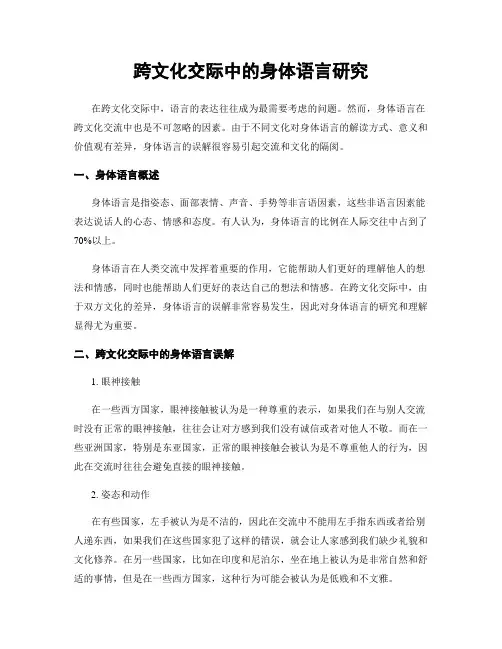
跨文化交际中的身体语言研究在跨文化交际中,语言的表达往往成为最需要考虑的问题。
然而,身体语言在跨文化交流中也是不可忽略的因素。
由于不同文化对身体语言的解读方式、意义和价值观有差异,身体语言的误解很容易引起交流和文化的隔阂。
一、身体语言概述身体语言是指姿态、面部表情、声音、手势等非言语因素,这些非语言因素能表达说话人的心态、情感和态度。
有人认为,身体语言的比例在人际交往中占到了70%以上。
身体语言在人类交流中发挥着重要的作用,它能帮助人们更好的理解他人的想法和情感,同时也能帮助人们更好的表达自己的想法和情感。
在跨文化交际中,由于双方文化的差异,身体语言的误解非常容易发生,因此对身体语言的研究和理解显得尤为重要。
二、跨文化交际中的身体语言误解1. 眼神接触在一些西方国家,眼神接触被认为是一种尊重的表示,如果我们在与别人交流时没有正常的眼神接触,往往会让对方感到我们没有诚信或者对他人不敬。
而在一些亚洲国家,特别是东亚国家,正常的眼神接触会被认为是不尊重他人的行为,因此在交流时往往会避免直接的眼神接触。
2. 姿态和动作在有些国家,左手被认为是不洁的,因此在交流中不能用左手指东西或者给别人递东西,如果我们在这些国家犯了这样的错误,就会让人家感到我们缺少礼貌和文化修养。
在另一些国家,比如在印度和尼泊尔,坐在地上被认为是非常自然和舒适的事情,但是在一些西方国家,这种行为可能会被认为是低贱和不文雅。
3. 面部表情和手势在跨文化交际中,面部表情和手势的误解也十分常见,比如在西方国家“露齿笑”被认为是友好和热情的表现,但是在一些东方国家,这样的笑容可能会被看做是虚伪的表现。
同时,在墨尔本,用“OK”的手势可能会被认为是公然侮辱他人的行为,这一点在中国和很多其他的国家可能就没有这样的含义。
三、为了更好地处理跨文化交际中的身体语言问题,需要加强跨文化交际的研究和理解。
在身体语言的角度下,可以通过分析不同文化之间身体语言的异同,寻找跨文化交际中身体语言误解的根源,选择最合适的身体语言表达和行为等等来实现跨文化交际的成功。
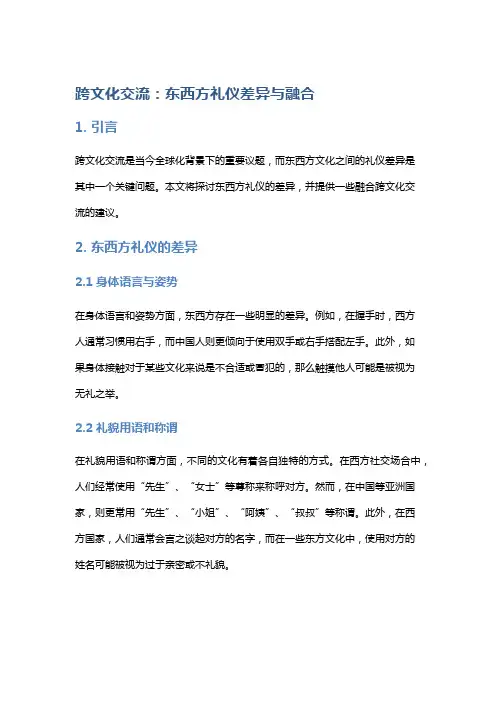
跨文化交流:东西方礼仪差异与融合1. 引言跨文化交流是当今全球化背景下的重要议题,而东西方文化之间的礼仪差异是其中一个关键问题。
本文将探讨东西方礼仪的差异,并提供一些融合跨文化交流的建议。
2. 东西方礼仪的差异2.1 身体语言与姿势在身体语言和姿势方面,东西方存在一些明显的差异。
例如,在握手时,西方人通常习惯用右手,而中国人则更倾向于使用双手或右手搭配左手。
此外,如果身体接触对于某些文化来说是不合适或冒犯的,那么触摸他人可能是被视为无礼之举。
2.2 礼貌用语和称谓在礼貌用语和称谓方面,不同的文化有着各自独特的方式。
在西方社交场合中,人们经常使用“先生”、“女士”等尊称来称呼对方。
然而,在中国等亚洲国家,则更常用“先生”、“小姐”、“阿姨”、“叔叔”等称谓。
此外,在西方国家,人们通常会言之谈起对方的名字,而在一些东方文化中,使用对方的姓名可能被视为过于亲密或不礼貌。
2.3 礼仪习惯与礼节东西方礼仪差异还体现在社交礼节和习惯上。
例如,在餐桌上,中国文化中用筷子进食,而西方餐桌上使用刀叉。
此外,在社交场合中,站立时给长辈让座是中国传统的尊敬之举,而在某些西方国家这种做法可能并不常见。
3. 跨文化融合与交流的建议3.1 学习对方文化为了更好地进行跨文化交流,我们需要学习并理解彼此的文化特点。
通过研究、阅读和参与相关活动,加深对对方文化的了解,并增进互相尊重和包容。
3.2 应变能力与灵活性在跨文化交流中,必须要具备应变能力和灵活性。
面对不同的礼仪差异时理解并尊重对方观念的同时也需要适度调整自己行为方式。
3.3 沟通和互动有效的跨文化交流依赖于良好的沟通和互动。
在交流中要注意用清晰简练的语言进行表达,避免因为语言障碍产生误解。
此外,主动表达兴趣和尊重对方文化是建立良好关系的关键。
3.4 灵敏度和尊重在跨文化交流中应有足够的灵敏度和尊重他人差异。
避免做出冒犯或不适当的举止,愿意倾听对方并接受不同文化背景下可能产生的行为差异。

肢体语言的中西方文化差异尼泊尔人、斯里兰卡人和有些印地安人和爱斯基摩人用点头表示“不”。
因此,要用外语进行有效的交际,在说某种语言时就得了解说话人的手势、动作、举止等所表示的意思。
我们可以观察一下阿拉伯人同英国人谈话。
阿拉伯人按照自己的民族习惯认为站得近些表示友好。
英国人按照英国的习惯会往后退,因为他认为保持适当的距离才合适。
阿拉伯人往前挪,英国人往后退。
谈话结束时,两个人离原来站的地方可能相当远!在这个例子里,双方的距离是关键。
不同的民族在谈话时,对双方保持多大距离才合适有不同的看法。
根据研究,据说在美国进行社交或公务谈话时,有四种距离表示四种不同情况:关系亲密,私人交往,一般社交,公共场合。
交谈双方关系亲密,那么身体的距离从直接接触到相距约45厘米之间,这种距离适于双方关系最为亲密的场合,比如说夫妻关系。
朋友、熟人或亲戚之间个人交谈一般以相距45~80米为宜。
在进行一股社交活动时,交谈双方相距1.30米至3米;在工作或办事时,在大型社交聚会上,交谈者一般保持1.30米至2米的距离。
在公共场合,交谈者之间相距更远,如在公共场所演说,教师在堂上讲课,他们同听众距离很远。
多数讲英语的人不喜欢人们离得太近,当然,离得太远也有些别扭。
离得太近会使人感到不舒服,除非另有原因,如表示喜爱或鼓励对方与自己亲近等,但这是另一回事。
记住这一点很重要。
在英语国家里,一般的朋友和熟人之间交谈时,避免身体任何部位与对方接触。
即使仅仅触摸一下也可能引起不良的反应。
如果一方无意触摸对方一下,他(她)一般会说Sorry;Oh,I’m sorry;Excuse me 等表示“对不起”的道歉话。
在中国,常常听到西方妇女抱怨中国人抚弄了她们的婴儿和很小的孩子。
不论是摸摸、拍拍、接接或是亲亲孩子,都使那些西方的母亲感到别扭。
她们知道这种动作毫无恶意,只是表示亲近和爱抚而已,所以也不好公开表示不满。
但在她们自己的文化中,这种动作会被人认为是无礼的,也会引起对方强烈的反感和厌恶。
从肢体语言差异看中西方文化的不同在进步着,每一个阶段人们的进步也同步反映在了人们的沟通方式上。
例如,人类最初阶段是用肢体语言来沟通的身体时代;第二阶段是用真正的语言来沟通的嘴巴时代;第三阶段是用书写文字来沟通的手写时代;第四阶段是用键盘沟通的十指时代;第五阶段就是当代用手机短信来沟通的拇指时代。
确实,从古至今不同地区和不同时代人们的沟通方式不尽相同,但每一个阶段人们的沟通都离不开最初的肢体表达方式.肢体语言是指能够某种特定信息的面部表情、手势语或者其他身体部位的动作等。
这是人们最初交流沟通的方式,也许口头表达出来的语言会说谎,但是肢体语言是相对比较真实的。
特别是不同语言国家的人之间交往时,肢体语言往往发挥了很大的作用.ﻭ在进行一般社交活动时,肢体语言相对比较灵活,也就是说,肢体语言种类比较多;同时,同一种肢体语言在不同的文化中所代表的含义也各不相同.因此,要用外语进行有效交际,在说某种语言时就得了解说话人的手势、动作、举止等所表示的意思。
握手是社交中的礼节,但中英握手的礼节形式差异较大.西方英语国家握手的方式是:两人以手相握,然后马上松开,两人的距离也随即拉开。
人的礼节性动作是:两人先握一下手,然后相互靠近,两人的手扔不松开,或者干脆变成相互抓住不放了。
对此,英语国家的人们往往窘迫不堪。
他们认为,身体之间的距离显得过于,抓住别人的手不放与握手毫不相干,人如此握手甚至会招致恋之嫌,因此,一般视为。
另外,西方国家的男女相见时一般要由女士采取主动,除非男士身份很高或者年龄很大,人之间的交往没有女士优先的礼俗。
两人相见时是否握手,一般由上级或者长者决定。
ﻭ除了在一般社交中的握手礼仪的差异,和拥抱的肢体表达方式也不尽相同。
在西方国家,这些即使在公共场合也会做得从容不迫、运用自如,但在,公共场合做起来却觉得别扭.这是因为两种文化的背景不同,长期受封建礼教的压抑,在情感表现形式上一向非常含蓄。
例如,在西方国家,久别重逢的母女在机场或者其他场合会激动地拥抱、;而在,历经艰辛再次见面的母女可能会激动地抱头痛哭,即使拥抱,也绝不会。
体态语的交际功能及英汉体态语的文化差异体态语是指人们在交流中通过肢体动作和面部表情等非语言方式来传达信息和情感的一种方式。
它是交际中不可或缺的一部分,起着非常重要的作用。
通过观察体态语,我们可以更好地理解对方的内心想法,增进沟通的效果,打破语言障碍,建立更加紧密的人际关系。
在英汉两种语言中,体态语的文化差异表现得尤为明显。
在英语国家,人们通常会用手势来强调自己的说话内容,比如挥动手臂表示兴奋或着急,点头示意同意,摇头表示不同意等等。
而在中国,人们则更倾向于用微笑、眼神交流和姿势动作来表达情感。
比如微笑可以表示友好和亲近,直立身体可以显得自信和有礼貌,低头则表示尊重和谦虚等。
此外,在英汉两种文化中,一些体态语的含义也有所不同。
比如在英语中,竖起拇指表示“好的”或是“赞同”,但在中国可能会被理解为“真棒”或是赞美的意味。
再比如,在中国,握拳弯腰行礼是一种尊重的表达方式,而在西方国家可能被误解为受挫或懦弱。
因此,跨文化交流中,理解并尊重对方的体态语文化是至关重要的。
在日常生活中,我们也可以通过观察和学习对方的体态语来更好地融入当地文化,提升跨文化交流的能力。
比如,在与英语国家的人交流时,可以适当运用手势来增强语言表达的效果,让对方更容易理解我们的意思。
而在与中国人交流时,可以通过微笑、眼神交流和动作姿势来传递友好和亲近的信息,促进沟通与融洽。
总的来说,体态语在交际中起着非常重要的作用,它不仅可以增进沟通效果,还能够打破语言障碍,增强人际关系的密切程度。
而在跨文化交流中,了解和尊重不同文化的体态语习惯更是至关重要。
通过观察、学习和适应,我们可以更好地融入当地文化,促进国际友谊的发展,实现跨文化交流的成功。
愿我们在不同文化的碰撞中,能够更好地理解彼此,创造更加美好的未来。
跨文化交际中中西方社会文化差异的表现跨文化交际不仅仅是语言的交流,也涉及到文化及历史的差异。
在中西方社会文化差异的表现中,有许多不同的方面。
在社会礼仪方面,中西方社会对于礼仪的要求不同。
在西方国家,礼仪主要体现在对于时间的要求上,精确守时被视为一种重要的表现方式,因此西方人会比较在意准时到达会议、约会等场合。
而在中国社会中,礼仪则强调对长辈和上司的尊重,因此在与长辈和上司的相处中,中国人更注重言谈举止和身体姿态。
在衣着文化方面,西方人在服装搭配方面更加注重个性和时尚,比如西装领带、高跟鞋等,而中国人则更注重传统文化和社会的价值观念,如汉服、旗袍等传统服饰。
在交际方式方面,中西方社会的人们也有着很大的差异。
在西方社会中,人们更加倾向于开放直白的交际方式,更注重表达自我,然而在中国文化中,人们则更加注重防范自我,倾向于更加保守的交际方式。
在中式的交往过程中,中国人区别对待身份地位高低,使用不同的称呼和敬语,和长辈和上司之间的交流和年轻人之间的交流,使用的语言和态度都有很大的不同。
在饮食文化方面,中西方社会也有着很大的差异。
在西方社会中,主食往往是面包、米饭、糕点等简单精致的食品,主要通过口感来体验美味。
而在中国饮食文化中,人们更加注重食物的色、香、味、形,讲究搭配和营养搭配,打造出丰富的美食文化。
在教育文化方面,中西方社会也存在很大的差异。
在西方教育文化中,教师和学生之间的关系往往比较平等,学生可以对老师提出独特和不同的观念和看法。
而在中国教育文化中,教师和学生之间的关系更加注重敬重和纪律,相较于西方一些国家,中国学生的教育是更加注重传统与基本功的。
在思维方式方面,中西方社会也有很大的差异。
在中国社会中,人们往往更加注重整体性思维,将各个事物看作是一个整体,相互关联,而欧美社会注重分析和剖析,更加注重细节和精细。
总之,在中西方社会文化差异的表现中,除上述方面外,还有很多其他的方面如在礼物、拜访,生活方式等等方面。
东西方各民族体态语的差异现在人们在社交中一般靠语言进行交流,语言所传递的信息可以没有穷尽,信息的内容也可以跨越时空。
但是人们在信息传递中可以借助语言之外的其他形式,比如体态语。
体态语是一种表达和交换信息的可视化(有的伴声)符号系统,它由人的面部表情、身体姿势、肢体动作和体位变化等构成。
或者通俗地讲,当人体动作能够传递相关信息时,这些动作有了语言的功能,就成为体态语了。
在现实生活中,体态语使用极其广泛,而且有时更能无声胜有声地巧妙表达信息,同时留给对方更大的想象空间。
虽说体态语在给我们的交流带来便利的同时,也带来了一些麻烦。
由于各民族所植根的文化传统和宗教信仰的不同,所使用的体态语自然也不同。
如果你不了解这些差异,在跨文化交际中会造成一定的误解。
在了解各族体态语差异之前,我们先讲一个有关这方面的小故事。
有一次一个日本人第一次到美国,在机场问一个美国旅客,机场是否提供行李车服务。
美国用一个OK手势答复,意思是免费提供。
日本人却误认为是很昂贵。
旁边一个突尼斯人看到了,认为美国人暗示他:“他是一个是一个卑鄙无耻的小偷,”让他小心点,否则杀死他。
从这则小故事可以看到体态语在各民族中差异甚大。
我们想要随心所欲的使用这种“无声胜有声的语言”,必须了解和掌握这其中的差异,尤其是东西方的差异。
原因是东方人内敛,谦虚,谨慎和西方人的外向,自信,坦率,这种根本上的差异使得体态语的表达也不同。
我们可以从以下四个方面把握。
首先是社交距离。
西方人比较注重隐私,而中国人对这方面比较单薄。
一般有这样四种界限表示四种不同情况:关系亲密、私人交往、一般社交、公共场合。
交谈双方关系亲密,那么身体的距离从直接接触到相距约45厘米之间,这种距离适于双方关系最为亲密的场合,比如说夫妻关系。
朋友、熟人或亲戚之间个人交谈一般在相距45~80厘米为宜。
在进行一般社交活动时,交谈双方相距1.3米至3米之间;在工作或办事时,在大型社交聚会上,交谈者一般保持1.3米至2米的距离。
从跨文化交际角度浅析中外体态语的差异
提到人与人之间的交流,我们通常总是首先想到语言,但语言只是人们进行交流的主要
途径之一,却不是传递和领悟信息的唯一途径。人们还用许多其他手段表达自己的思想感情,
传达各种信息,这就要依赖于非语言交际的手段。而体态语,也就是我们平常所说的肢体语
言,就属于人类交际活动中非语言交际的一种,它通常伴随着言语交际或者是单独表示而达
到信息交流的目的。体态语随着不同的国度不同的文化其表达的意义并不完全相同,在跨文
化交际中若不了解这一点则会影响双方的交流,甚至产生误会。下面我将针对体态语言的几
个重要方面例举一些中外体态语的差异并且谈谈我的看法。
一、人际交往的空间距离
当人们进行交际的时候,交际双方在空间所处位置的距离具有重要的意义,它不仅告诉
我们交际双方的关系、心理状态,而且也反映出民族和文化特点。不同的民族在谈话时,对
双方保持多大距离有不同的看法。美国人类学家霍尔通过研究发现,人们在交往中的距离领
域大致可以分为四种类型:亲密距离,私人距离,社交距离和公共距离。
(1)亲密距离( 0-45cm),就交往情境而言,亲密距离属于私下情境,只限于在情感上联
系高度密切的人之间使用。在同性别的人之间,往往只限贴心朋友,彼此十分熟识而随和。
在异性之间,只限于夫妻和恋人之间。
(2)个人距离(45—120era),是指一般私人关系交往的距离,比如同事,朋友,同学之间,
在交往中,应保持在不易接触对方身体的距离,一般表现为伸手能握到对方的手的距离为宜.
特别是在男女的一般交往中,尤应注意私人距离的分寸。
(3)社交距离(120—360era),通常是用于处理非个人事务的场合中,如进行一般社交活
动,或在办公,商务会谈或社交聚会时。
(4)公众距离(public distance360—750cm),这是公开演说时演说者与听众所保持的距
离。
不同民族与文化构成人们之间不同的空间距离,多数讲英语的人在交谈时不喜欢凑的太
近,而对俄罗斯人来说意大利人交谈时过于靠近,拉丁美洲人交谈时几乎贴身。在电梯、巴
士或火车上,素不相识的人拥挤在一起,东方人可以容忍身体与身体接触的那种拥挤,西方
人则无法容忍。
二、人际交往的身体接触
体触语作为一种借身体间接触来传达或交流信息的的体态语言,它富有强烈的感情色彩
和极强的文化特色。
在我国,由于文化传统的影响,人们在公开场合通常都不拥抱、接吻,对于西方文化中
的这一现象特别难于适应。在西方许多发达国家,两个女生见面时拥抱在一起是很常见的现
象,夫妻久别重逢时拥抱亲吻也非常自然;但阿拉伯人、俄国人、法国人、东欧人、地中海
沿岸和有些拉丁美洲国家的人,两个男人之间也会拥抱及亲吻双额。
在美国,男人之间的握手是很用力的;中国人一边讲“你好”一边握手,对此没有什么
忌讳,俄罗斯人则不允许两人隔着一道门或跨着门槛握手,他们认为这样做是不吉利的。拥
抱亲吻及握手的这些差异反映了不同文化的特色和浓厚的社会文化意义,也是不同民族之间
深层的差异在体态语这个表层上的具体表现。
三、面部表情和目光接触
人们常说“察言观色”“看脸色行事”,主要都是指观察人的面部表情。的确,借助和
利用面部表情可以更好地表达和传递自己的思想感情。但是,同样的面部表情在不同
的国家可能会有不同的含义。
例如,在西方一些国家,眨眼是一种感兴趣的表示,而在中国一些地方,冲陌生人眨
眼则是一种挑衅行为,冲女人眨眼更是不可为。如在中国和讲英语的国家不论微笑还是大笑,
通常表示友好、赞同、满意、高兴、愉快,但在某些场合,中国人的笑会引起西方人的反感。
有一个这样的例子,在餐厅里,一个外国人偶然摔了一个碟子,他本来就感到很窘,而在场
的中国人发出笑声,使他更加觉得不是滋味,又生气,又反感。当然,中国人的这种笑,并
非是嘲笑当事人,也不是幸灾乐祸。这种笑有很多意思。可以表示:“别当一回事儿”,“一
笑了之”,“我们也常干这种事”等。不过,对于不了解这些意思的人,这样一笑会使他们感
到不愉诀,而且会对发笑的人产生反感。
面部表情的一个重要方面是目光接触。在人际交往过程中,与交往对方保持目光接触是
十分必要的,但是文化对目光的接触和眼神的影响也是明显的。
在英语国家,盯着对方看或看得过久都是不合适的。即使用欣赏的目光看人——如对方
长得漂亮——也会使人发怒。而在中国,目不转睛地看可能仅仅是对某人某物感到好奇或者
是惊讶,自然不会引起别人的强烈反感。
四、人际交往中的手势语言
各民族都用手势表达一定的意义,但同一手势在不同的文化中却可以表达并不相同的
意义。例如,将手掌平放在脖子下面在我国文化中是杀头的意思。但是在英语国家的文化中
却可以表示吃饱了的意思。手指搭成圈状这一示意动作被广泛接受为美国的“OK”标志,但
也有例外。第二次世界大战以来,V字的形象在全世界都表示“胜利”。可是温斯顿·丘吉
尔对如何使用这个手势却很小心,因为如果把掌心朝外,两指作V字形手势,在欧洲大部分
地方是“胜利”的标志。但同样的手势,若掌心朝内,则表示“去你的!”而在非英语国家,
V字形手势通常意为“两个”,如“请再来两份啤酒”。因此,在跨文化交际中必须了解这
种差别,否则也许会表达错误的信息。
五、总结
体态语与语言一样,使用是相当广泛并且有交际作用的,它蕴含着丰富的文化内涵,体
现了人们的价值取向和行为准则。通过体态语这种特殊的表达方式,我们可以看出不同民族,
不同社会所表现出的不同文化特征。随着国际间跨文化交际的日益增多,为避免体态语中的
文化因素引起的交际障碍。在跨文化交际中,不仅要求语言得体,而且还要求动作得体。所
以,我们应在语言学习的同时,也要加强体态语的学习,了解其文化内涵,真正做到有效的
跨文化交际。